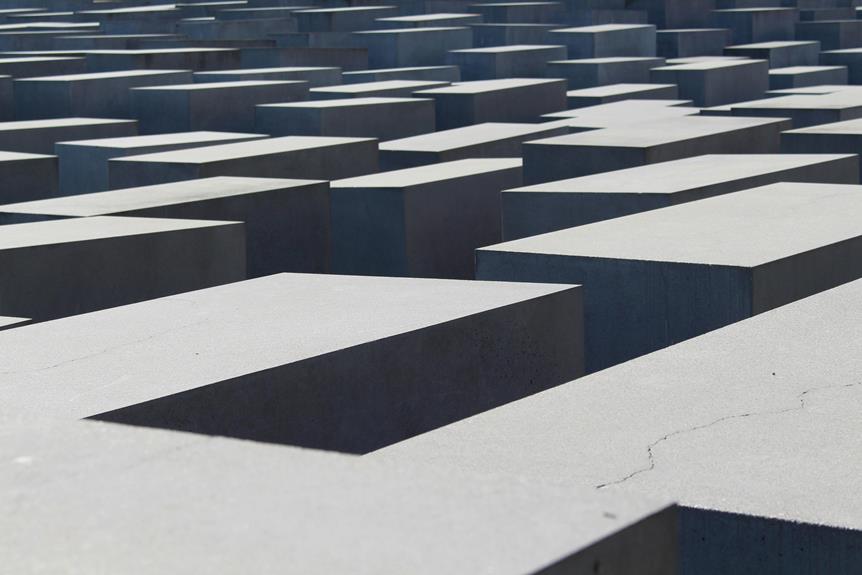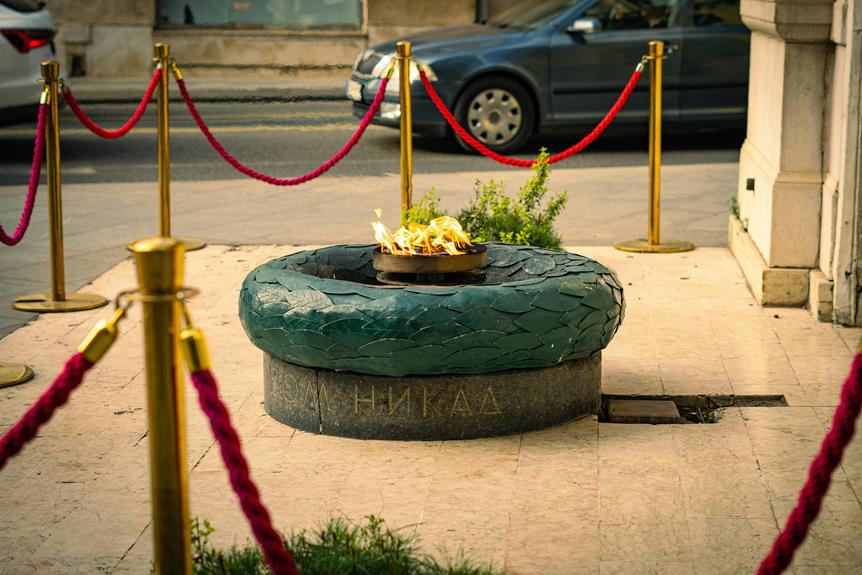The Memorial to the Murdered Jews of Europe in Germany serves as a solemn tribute to the victims of the Holocaust, evoking contemplation and remembrance through its stark design and immersive experience. As visitors navigate the labyrinth of concrete slabs, a sense of solemnity and reflection permeates the atmosphere, prompting introspection on the tragedies of the past. This monument stands as a testament to the enduring importance of preserving historical memory and honoring those who perished, inviting further exploration into the complexities of collective mourning and commemoration.
Key Takeaways
- Architectural design: 2,711 concrete slabs in grid pattern.
- Symbolism: Represents vastness of Holocaust atrocities.
- Visitor experience: Immersive, emotional, and contemplative.
- Community engagement: Involves schools, organizations, and the public.
- Impact on collective memory: Shapes German and global remembrance.
Historical Background
Initially established in the heart of Berlin, the Memorial to the Murdered Jews of Europe stands as a solemn reminder of the historical atrocities committed during the Holocaust. The Holocaust, perpetrated by the Nazi regime during World War II, led to the systematic extermination of six million Jews and millions of others deemed undesirable by the regime. The Memorial serves as a poignant symbol of remembrance for the victims of these heinous crimes and a warning against the dangers of intolerance and hatred.
The Nazi regime, under the leadership of Adolf Hitler, implemented policies aimed at the complete annihilation of Jewish people, resulting in one of the darkest chapters in human history. The Memorial stands as a physical representation of this tragic period, with its 2,711 concrete slabs, or stelae, arranged in a grid pattern over 4.7 acres. Visitors to the Memorial are encouraged to walk through the unevenly sloping ground, symbolizing the feeling of unease and disorientation experienced by the victims of the Holocaust.
Architectural Design
The architectural design of the Memorial to the Murdered Jews of Europe in Germany is characterized by its striking and symbolic arrangement of 2,711 concrete slabs spread across 4.7 acres. The layout of the slabs forms a grid pattern, creating a maze-like atmosphere for visitors to navigate. This design element has sparked various interpretations regarding its representation of the Holocaust experience.
The table below provides a breakdown of the key aspects of the architectural design, focusing on both the aesthetic appeal and structural integrity of the memorial:
| Aspect | Description |
|---|---|
| Aesthetic Appeal | The stark contrast between the towering slabs and the open sky evokes a sense of solitude and reflection. The uniformity of the design symbolizes the systematic nature of the atrocities committed. |
| Structural Integrity | Each concrete slab is precisely aligned and varies in height, creating an undulating ground that adds a sense of unease and disorientation. The durability of the materials used guarantees the longevity of the memorial, allowing future generations to engage with this somber history. |
| Symbolism | The grid layout and varying heights of the slabs represent the ordered system of oppression and the chaotic individual experiences within it. The design prompts visitors to contemplate the impact of collective tragedy on a personal level. |
The architectural design of the Memorial to the Murdered Jews of Europe masterfully combines aesthetic elements with structural functionality to create a poignant and thought-provoking space for remembrance and reflection.
Symbolism and Significance
Symbolism and significance are intricately woven into the architectural design of the Memorial to the Murdered Jews of Europe in Germany, embodying a profound narrative of remembrance and reflection. The memorial consists of 2,711 concrete slabs of varying heights and sizes, arranged in a grid pattern across a sloping field. This design symbolizes the vastness of the Holocaust and the individuality of each victim, with the uneven ground creating a sense of disorientation and unease for visitors as they navigate the maze-like pathways.
The stark, gray concrete slabs are devoid of any markings or inscriptions, allowing visitors to project their own emotions and interpretations onto the monument. This intentional lack of explicit symbolism encourages personal reflection and contemplation, emphasizing the universal nature of the tragedy and the importance of collective memory.
The memorial's underground Information Center complements the symbolic nature of the slabs above ground. Through curated exhibitions, testimonials, and historical documentation, the center serves as a representation of the individual stories and experiences of the millions who perished. By combining abstract symbolism with concrete historical representation, the memorial creates a multifaceted narrative that honors the victims while challenging visitors to confront the atrocities of the past.
Visitor Experience
Upon entering the Memorial to the Murdered Jews of Europe in Germany, visitors are enveloped in an immersive and contemplative experience that encourages reflection on the historical significance of the site. The visitor experience is carefully crafted to evoke a deep emotional impact and facilitate a connection with the tragic events of the past through interactive exhibits.
Key Aspects of the Visitor Experience:
- Emotional Impact: The memorial's design, characterized by its grid layout of 2,711 concrete stelae of varying heights, creates an atmosphere of solemnity and remembrance. As visitors walk through the unevenly sloping ground and amidst the towering structures, they are confronted with a sense of disorientation and isolation, mirroring the disorienting experience of the victims during the Holocaust.
- Interactive Exhibits: The onsite information center offers a wealth of resources including personal stories, historical documents, and interactive displays that provide context and detail about the Holocaust and the lives of the Jewish victims. These exhibits serve to educate visitors about the atrocities committed, ensuring that the memory of the victims is preserved and honored.
- Guided Tours: Knowledgeable guides lead tours that explore the historical background of the Holocaust, offering insights and perspectives that enhance the visitor's understanding of the memorial's significance. These tours provide a structured experience that aids in exploring the complex emotions evoked by the memorial's design and purpose.
Controversies and Criticisms
As discussions surrounding the Memorial to the Murdered Jews of Europe in Germany have evolved, various controversies and criticisms have emerged, shedding light on differing perspectives regarding its design and purpose. One of the main points of contention revolves around the ethical implications of the memorial's abstract design. Critics argue that the stark grey concrete slabs, without explicit references or explanations, could be interpreted in ways that undermine the gravity of the Holocaust. On the other hand, supporters believe that the open interpretation allows visitors to reflect personally on the tragedy without being guided by a singular narrative.
To further understand the controversies and criticisms surrounding the Memorial to the Murdered Jews of Europe, the table below outlines key points:
| Criticism | Counterargument |
|---|---|
| Lack of explicit historical context | Encourages personal reflection |
| Potential for trivialization | Facilitates diverse interpretations |
| Insufficient educational information | Promotes emotional connection |
| Minimal acknowledgment of individual stories | Emphasizes collective mourning |
Moreover, the memorial has been a focal point for political debates. Some argue that the abstract nature of the memorial reflects a desire to move beyond the specifics of the Holocaust, potentially aligning with broader political motives. Others contend that the memorial serves as a poignant reminder of the atrocities committed, regardless of political interpretations.
Educational Outreach
The implementation of educational outreach programs for the Memorial to the Murdered Jews of Europe in Germany aims to deepen public understanding of the Holocaust's historical significance and promote empathy towards its victims. These initiatives are vital in fostering a sense of remembrance and respect for the millions who perished during this dark period in history.
To achieve these objectives effectively, the following strategies are employed:
- Community Engagement: By reaching out to schools, universities, local organizations, and the general public, the memorial's educational outreach programs aim to involve the community in discussions and activities that highlight the importance of remembering the Holocaust. Through partnerships with diverse groups, the memorial can reach a wider audience and create a more inclusive learning environment.
- Interactive Workshops: Interactive workshops offer participants a hands-on learning experience that goes beyond traditional educational methods. These workshops may include guided tours, storytelling sessions, artifact exhibitions, and group discussions. By actively engaging individuals in the learning process, interactive workshops help make the historical narrative more relatable and impactful.
- Digital Resources: In today's digital age, online platforms and resources play a significant role in educational outreach. The memorial leverages digital tools such as virtual tours, interactive websites, educational videos, and social media campaigns to reach a global audience and make information about the Holocaust more accessible. These resources complement on-site educational programs and enable continuous learning beyond physical visits to the memorial.
Maintenance and Preservation
Implementing rigorous maintenance and preservation practices is crucial for guaranteeing the longevity and integrity of the Memorial to the Murdered Jews of Europe in Germany. The preservation challenges faced by the memorial are significant due to its size and design complexity. The site covers a vast area, and the 2,711 concrete slabs, known as 'stelae,' require regular inspection for signs of wear, cracks, or other damage. Additionally, the underground Information Centre necessitates specialized conservation efforts to maintain the historical artifacts and exhibitions housed within.
| Preservation Challenges | Restoration Efforts |
|---|---|
| Weathering of concrete slabs | Regular cleaning and sealing of the stelae |
| Graffiti and vandalism | Swift removal and restoration of affected areas |
| Structural integrity of stelae | Ongoing inspection and repair work |
| Preservation of historical artifacts | Climate control and conservation measures in the Information Centre |
| Environmental factors | Monitoring and mitigating effects on the memorial |
To address these preservation challenges, continuous restoration efforts are essential. Regular cleaning and sealing of the stelae help combat weathering, while swift removal and restoration actions are taken in response to graffiti and vandalism. Structural integrity is ensured through ongoing inspection and repair work, and the conservation of historical artifacts is maintained through climate control and conservation measures in the Information Centre. Monitoring environmental factors and implementing appropriate mitigation strategies are crucial to preserving the Memorial to the Murdered Jews of Europe for future generations.
Impact on Collective Memory
The Memorial to the Murdered Jews of Europe in Germany has a profound impact on collective memory. It evokes contemplation and reflection on the historical atrocities endured, shaping the collective memory of the German population and visitors worldwide.
- Acknowledgment of Collective Trauma: The memorial represents the collective trauma of the Jewish population during the Holocaust. Confronting the stark reality prompts individuals to acknowledge the deep scars left by this tragic period in history.
- Promotion of Cultural Reconciliation: Through its somber design, the memorial fosters cultural reconciliation by encouraging dialogue and understanding between different communities. It symbolizes a commitment to learning from the past for a more harmonious future.
- Educational Tool for Future Generations: Acting as a poignant reminder of the Holocaust atrocities, the memorial serves as an educational tool for future generations. It keeps the memory of the Holocaust alive, helping prevent such horrors from being repeated.
Global Remembrance
An examination of the Memorial to the Murdered Jews of Europe reveals its significant impact on fostering global remembrance of the Holocaust. This commemorative art installation in Berlin serves as a poignant reminder of the atrocities committed during one of the darkest periods in human history. The memorial's stark design, featuring 2,711 concrete slabs of varying heights, evokes a sense of loss, disorientation, and collective mourning. As visitors navigate through the uneven pathways, they are confronted with the enormity of the Holocaust, prompting reflection on the six million Jewish lives lost.
Beyond its physical presence in Berlin, the Memorial to the Murdered Jews of Europe plays an important role in Holocaust education and promoting global remembrance. By serving as a site for contemplation and learning, the memorial contributes to raising awareness about the horrors of the Holocaust and the importance of combating anti-Semitism and bigotry worldwide. Through guided tours, educational programs, and online resources, the memorial facilitates dialogue on the historical significance of the Holocaust and its enduring impact on contemporary society.
In a world where the memory of past atrocities is fading, initiatives like the Memorial to the Murdered Jews of Europe stand as beacons of remembrance and resistance against forgetting. By engaging with this powerful symbol, individuals from all walks of life can honor the victims, learn from history, and reaffirm their commitment to upholding freedom, tolerance, and human rights for future generations.
Frequently Asked Questions
Is There a Specific Time of Day When the Memorial Is Most Impactful?
The impact of a memorial can vary based on the time of day. Sunrise reflection offers a serene ambiance, symbolizing hope and renewal.
Midday shadows cast a sense of solemnity and remembrance.
Evening illumination brings a sense of reverence and contemplation.
Twilight, with its fading light, invites introspection and quiet reflection.
Each time of day carries its unique emotional resonance, allowing visitors to experience the memorial in different perspectives.
Are There Any Hidden Symbols or Messages Within the Memorial?
In examining memorials, it is common to seek hidden symbols or messages that enrich their meaning. Symbolism often plays a pivotal role in the design of such monuments, conveying deeper layers of significance and serving as a form of communication beyond words.
A meaningful design can incorporate various elements that evoke emotions, historical references, or philosophical concepts, inviting visitors to reflect on the memorial's purpose and the events it commemorates.
How Do Local Residents Feel About the Memorial's Presence?
Local opinions on the presence of the memorial are varied, reflecting complex community relations. Some residents view it as an important reminder of history, fostering reflection and education, while others may find it a somber reminder that brings discomfort.
The memorial's impact on the local community is a topic of ongoing discussion, with differing perspectives on its significance and how it shapes the collective memory and identity of the area.
Are There Any Annual Events or Ceremonies Held at the Memorial?
Annual events and ceremonies at memorials play a vital role in preserving cultural significance and historical importance. Commemorative events provide a platform for collective remembrance and reflection on the past.
Such memorial ceremonies serve as a way to honor the memory of those affected by tragic events and guarantee that their stories are not forgotten. These gatherings often attract visitors seeking to pay their respects and learn from the lessons of history.
Can Visitors Leave Personal Tributes or Messages at the Site?
Visitors often wonder about leaving personal tributes or messages at memorial sites. It is essential to understand the etiquette guidelines in place.
This practice is culturally significant as it allows for artistic expression and historical context. While some memorials encourage this form of remembrance, others may prohibit it to maintain the sanctity of the site.
Understanding the balance between honoring the past and respecting the present is pivotal in such cases.
Conclusion
To sum up, the Memorial to the Murdered Jews of Europe in Germany serves as a powerful symbol of remembrance and reflection on the Holocaust.
One striking statistic is that the memorial receives approximately 500,000 visitors annually, highlighting its significance as a place of historical education and commemoration.
Its architectural design and immersive experience create a lasting impact on collective memory, challenging visitors to confront the horrors of the past and honor the victims of this tragic chapter in history.


